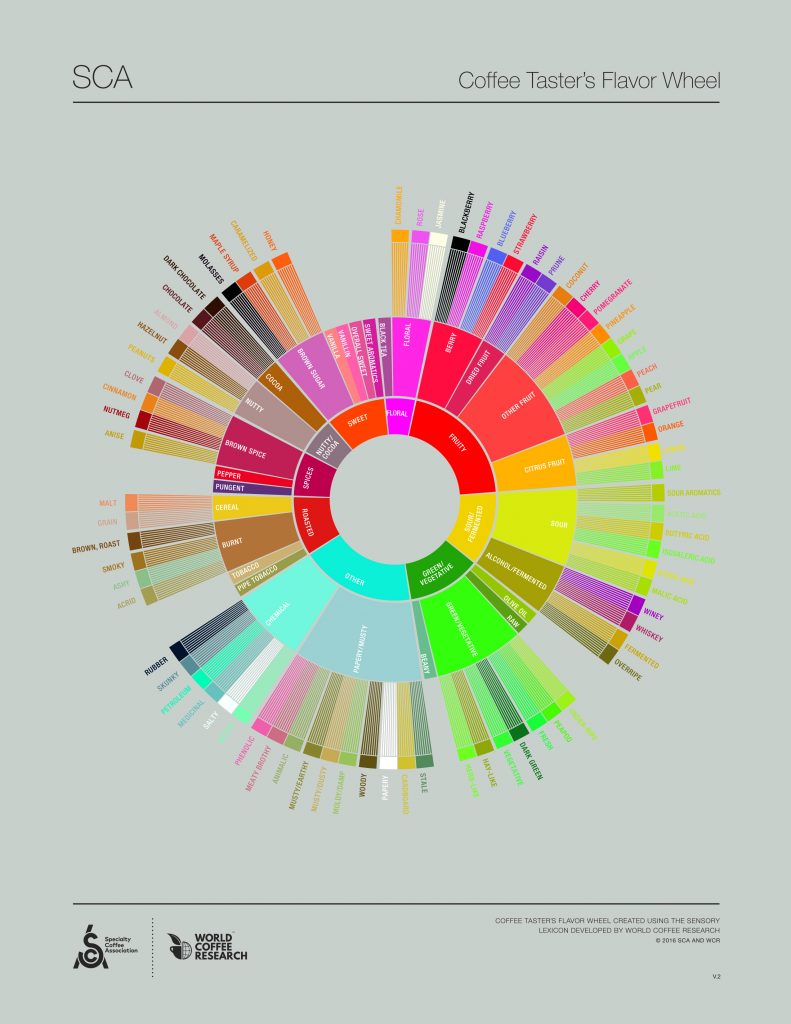Identifying coffee tasting notes can seem challenging, intimidating and out of reach. For those of you who hear someone describe wine tasting notes and roll your eyes, I totally get it – the idea that you can taste anything besides the flavor of wine itself sounds bizarre. I often receive a similar reaction when I tell people I can taste blueberries or watermelon in a coffee.
This guide will walk you through a few tools that make the process of identifying coffee tasting notes interesting and easy – giving you the confidence to describe coffee and, ultimately, enrich your coffee-drinking experience.
Navigating the Wheel
The industry standard for describing coffee tasting notes is the Specialty Coffee Association’s Coffee Taster’s Flavor Wheel. The SCA Flavor Wheel features a range of tasting notes and is designed for the taster to start with broader qualities in the middle of the wheel, with notes including floral, sweet, nutty/cocoa, spices, roasted, green/vegetative, sour/fermented and other. As you move from the center of the flavor wheel outward, each flavor becomes more and more precise; nutty/cocoa, for example, is further specified as a range from dark chocolate to peanut. Similarly, fruity can be further characterized as berry, citrus, dried and other fruits. Citrusy can then be defined more specifically as lime or grapefruit.
Each of these descriptors is included in the Lexicon World Coffee Research Sensory, a collection of terms which includes identifiers for the ranges of flavors within each category. Think about a blueberry’s taste descriptors, for example: some are small and tart, others are large and creamy. Some blueberries are baked, which taste differently than blueberry hard candies. These reflect the range of just one flavor. Each descriptor on the flavor wheel has a description as well as a reference, for calibration. Some coffees shift through multiple categories as the temperature moves from hot to cold. For instance, some coffees may start fruity while hot, and become sour or fermented as they cool.
Top Half vs. Bottom Half
The flavor wheel is also broken down by favorable and unfavorable qualities. The top half is defined by desirable qualities, describing sugary flavors and floral or fruit-like sweetness. The bottom half maps unfavorable qualities such as burnt, chemical, vegetative or fermented. If you taste a chemical, rubber or medicinal quality in your coffee, this can be attributed to a defect in the quality of the bean itself. It may not have been sorted or dried properly at the farm, giving it that unpleasant quality. When I spent time in Colombia, I tasted an entire table of defects, each tied to a particular scenario at the farm.
Also included in the bottom half of the tasting wheel are roast issues. If you taste hay-like, vegetal or fresh peas in your coffee, the beans may not have been roasted long enough, manifesting in these underdeveloped characteristics.
Color
The colors on the flavor wheel were chosen very specifically. We associate chocolate and nut like flavors with brown and neutral colors, while ‘bright’, ‘red’ or ‘green’ flavors can be linked to citrus, berry or tropical fruits. This is especially helpful for visual learners like myself. Sometimes when I taste coffee, I can actually think about it in terms of color. I’ll immediately start thinking of purple, green, or yellow colors and then I can narrow it down to grape, kiwi, or lemon.
I’ve found that tasting a variety of different fruits, nuts, chocolates and even sugars has helped me to better understand and identify tasting notes. I can differentiate cane sugar sweetness from honey from raw sugar. I can understand the differences between almond, walnut and peanut flavors in coffee.
It really is all about practice, tasting, and referring back to the flavor wheel. Try it out! I bet you’ll find that using the Tasting Wheel can help you better understand your own tastes and identify your favorite coffees.


